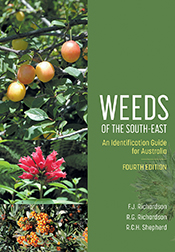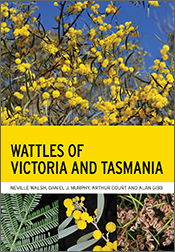Plants of Western New South Wales
By: GM Cunningham, WE Mulham, PL Milthorpe, JH Leigh
eBook - July 2011 - eRetailers
A comprehensive record illustrating and describing the great array of plants in Western New South Wales.
Plants of Western New South Wales grew from the long experience and expertise which the authors acquired during their employment with their respective organisations in the arid and semi-arid pastoral areas of the State. Each author became aware of the need for a comprehensive record illustrating and describing the great array of plants in the area. The need was identified both for people involved in research and advisory services, and particularly for the landholders who need to manage the plants for their livelihood. + Full description
The book is a landmark because it draws together all of the existing knowledge of plants from the area, adds to it the extensive collections and research of the authors and presents the whole as a comprehensive collation and description of the plants of the dry pastoral portion of the State. Because of its comprehensive nature, the work is significant to pastoralists and people concerned with plants throughout Australia.
The 1992 edition of Plants of Western New South Wales has been reprinted and published by CSIRO PUBLISHING with a one page appendix giving website addresses of various herbaria in Australia where the reader can readily access up-to-date information on botanical name changes.
- Short descriptionNews
This title is no longer available in print format.
Features
- Describes 2027 plants recorded from western NSW
- Contains colour photographs of approx. 1500 of these species
- Has an introductory section that describes the climate, soils and vegetation communities of western NSW
- Individual descriptions provide not only a description of each species in layman’s terms but details of pastoral value, poisonous properties, distribution and flowering/seeding data
- It is the only work that comes anywhere near describing the flora of the western part of the State in such detail and is used widely in the more easterly farming districts of NSW by government organisations, farmers and environmentalists
Authors
Principal AuthorGeoffrey Mc Iver Cunningham was a Soil Conservationist with the former Soil Conservation Service of NSW and its later entity, the Department of Conservation and Land Management, from 1963 to 1992. He spent some 20 years working in western NSW and during this time the field work for Plants of Western NSW was undertaken.
He began his career in western NSW as a Soil Conservationist at Condobolin and then Nyngan and later became the equivalent of Regional Director of Soil Conservation for the western half of the State at Condobolin for some 12 years.
Geoff left the west for a 2 year period as Regional Director of Soil Conservation for the Metropolitan Area, based at Goulburn and in 1983 transferred to the organisation’s Head Office in Sydney as Chief of Services and later Executive Director, Planning and Development.
He has retained a deep interest in the flora of the west and in 1992 left the Public Service to establish his own consultancy company – Geoff Cunningham Natural Resource Consultants Pty Ltd – that specialises in flora and soil surveys. Much of the work that he has undertaken in his consultancy role has been associated with the western flora.
Geoff has published extensively in the flora, land inventory and rangeland management fields.
Co-authors
William Edward Mulham began his career with CSIRO at Deniliquin in 1948 and until retiring in December, 1986 had spent almost 30 years of involvement with research projects in the rangelands of western NSW.
During his 30 years of involvement with the rangelands of western NSW, Bill worked on a variety of projects related to the natural environment under a wide range of seasonal and management impacts. He has been associated, mostly as a joint author, with the publication of over 20 papers in scientific journals, on studies such as plant population dynamics, herbivore diets, impact of domestic herbivores and fire on rangeland vegetation, range condition monitoring, and selection and testing of introduced forage plants. On his retirement in 1986 his position within the CSIRO Division of Wildlife and Ecology, Rangelands Research Unit, Deniliquin, was that of Experimental Scientist. After retirement he undertook a number of private consulting projects involving plant dynamics and vegetation assessment.
Peter Lindsay Milthorpe commenced work with the Soil conservation Service of NSW in 1967, principally undertaking agrostological and advisory work. From 1969 Peter co-developed, implemented and managed a resource inventory scheme using land system mapping in semi-arid NSW. The data collected from this work forms the basis for property planning, developing management strategies and for preparing regional environmental assessments.
Between 1981 and 2005, Peter worked with NSW Agriculture (now Industry and Investment) assessing the potential of new industrial and essential oil crops for semi-arid areas. Species such as Guayule (natural rubber), buffalo gourd (starch, oil and protein), Grindelia (gum and resins), tagasaste (tree fodder), jojoba (industrial oil), mallee (essential oil of Eucalyptus spp.) and native forage shrubs (principally old man saltbush) were evaluated.
As a result of his work three varieties of jojoba have been released for commercial production under Plant Variety Rights (PVR) and the jojoba industry formed in Australia. Similar selection work and evaluation of yield potential has been completed on two species of oil mallee with several promising cultivars selected and now propagated for production.
Peter has published extensively in refereed scientific journals as well as several books on the flora.
John Holland Leigh retired as a Senior Principal Research Scientist with CSIRO Division of Plant Industry in the mid-1990s. During the period 1960–1969 he was based at CSIRO’s Riverina Laboratory at Deniliquin where he undertook research into animal–plant relationships in several semi-arid vegetation communities.
After his transfer to Canberra, John continued to examine the interactions between fire and grazing animals on sub-alpine and high rainfall grasslands.
John has also been involved in categorising the risk status of rare and threatened Australian plants and promoting their conservation.
During his career, John prepared over 90 peer-reviewed papers, six books and numerous book chapters.








